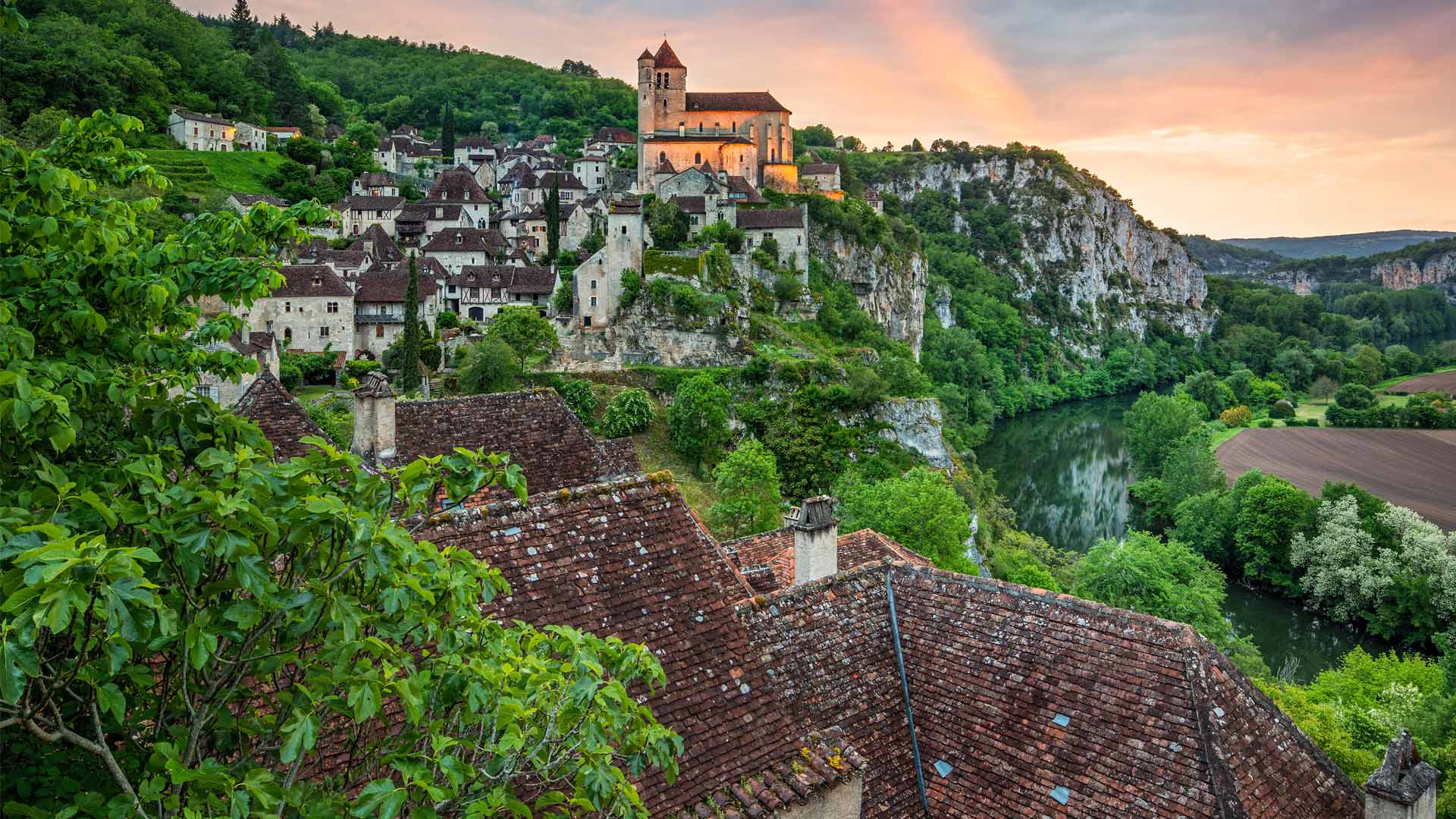堡垒山上的珀纳里城堡,法加拉斯山,罗马尼亚 Poenari Castle on Mount Cetatea, Făgăraș Mountains, Romania (© porojnicu/Getty Images)
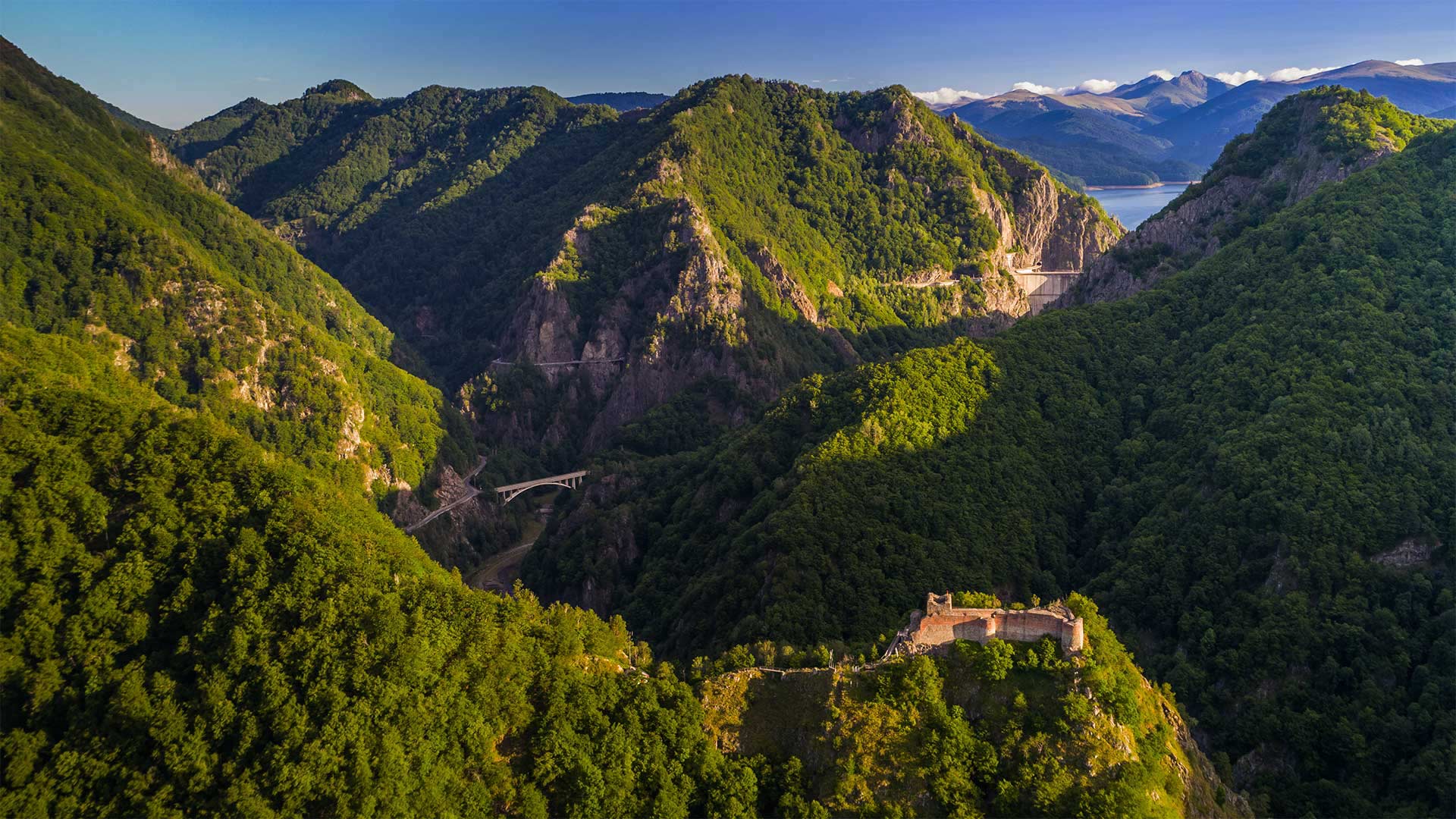
堡垒山上的珀纳里城堡,法加拉斯山,罗马尼亚 Poenari Castle on Mount Cetatea, Făgăraș Mountains, Romania (© porojnicu/Getty Images)
A castle fit for a count
Peeking out above the trees in the Făgăraș Mountains of Romania is Poenari Castle, an ancient structure whose reputation is steeped in history and legend. In the 15th century this castle was occupied by the notoriously ruthless ruler Vlad III, aka Vlad the Impaler, aka Vlad Dracula. Vlad wasn't a vampire, but he was known for treating his enemies with particular cruelty. His bloody resistance to Ottoman encroachment would make him a national hero and the subject of much folklore, some of it gruesome. These tales are likely what inspired author Bram Stoker to name his fictional vampire Count Dracula.
Poenari Castle continued to be used following Vlad's death in 1476 but was abandoned decades later. It fell into ruin over the centuries, as earthquakes and landslides sent parts of the building down the cliff and into the Argeș River below. Visiting the ruins today requires determination and stamina—it's a 1,480-step climb to the citadel walls, unless you're able to take the form of a bat and fly to the top.
格加尔德修道院,亚美尼亚 Geghard Monastery, Armenia (© traumlichtfabrik/Getty Images)
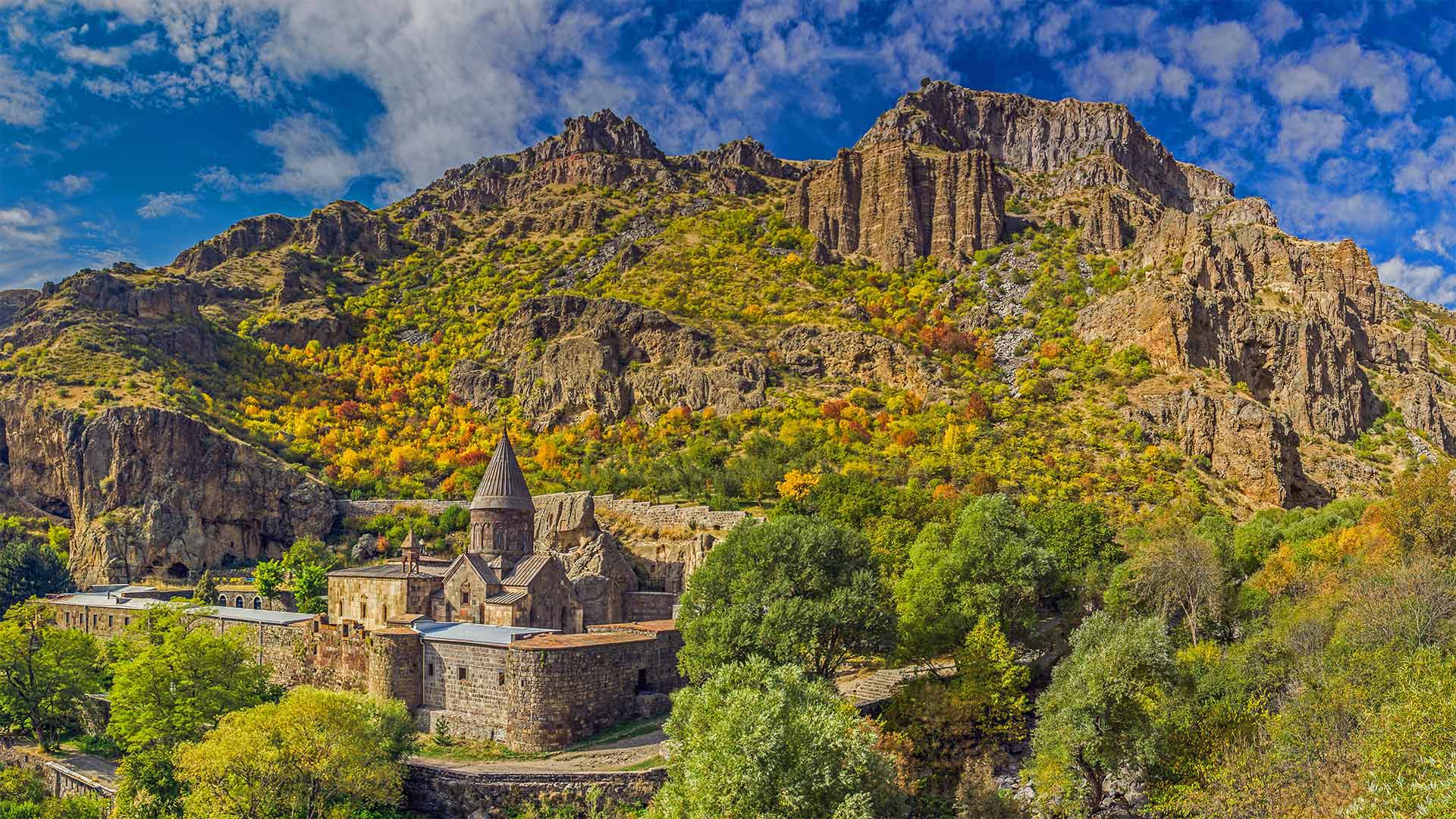
格加尔德修道院,亚美尼亚 Geghard Monastery, Armenia (© traumlichtfabrik/Getty Images)
A monastery in the mountain
Built into the side of a mountain in the Azat Valley of Armenia, Geghard Monastery is one of the most-visited tourist destinations in the country. The location of the monastery has been inhabited for millennia and venerated by locals since the pre-Christian era due to the spring which emanates from one of the caves in the mountainside. The monastery was originally founded in the 4th century by Saint Gregory the Illuminator—the patron saint of the Armenian church—though none of the original buildings survive.
The buildings comprising the existing complex were begun in the 13th century and are now regarded as some of the best-preserved examples of medieval Armenian architecture. But what really makes the complex unique are the monastic cells and chapels hewn directly into the mountain itself, with elaborate bas relief ornamentations and multiple exquisite examples of Armenian stone crosses, or 'khachkar,' throughout. Designated a UNESCO World Heritage Site, protections extend to both the monastery complex and the surrounding countryside, making a trip there an opportunity to step back into the medieval world.
俯瞰正在飞越洛斯罗克斯群岛国家公园的美洲红鹳,委内瑞拉 Aerial view of American flamingos flying over Los Roques Archipelago National Park, Venezuela (© Cristian Lourenco/Getty Images)
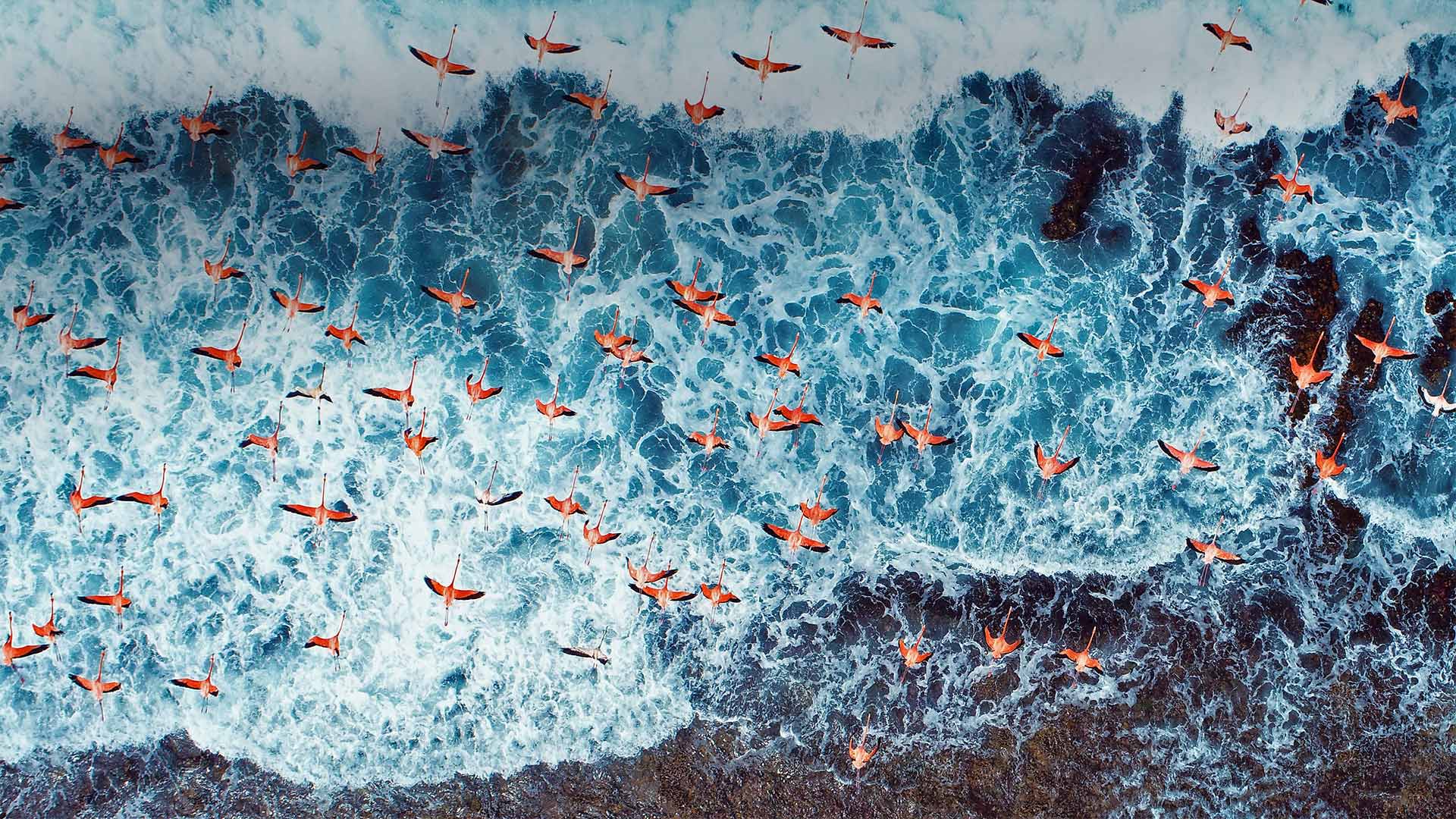
俯瞰正在飞越洛斯罗克斯群岛国家公园的美洲红鹳,委内瑞拉 Aerial view of American flamingos flying over Los Roques Archipelago National Park, Venezuela (© Cristian Lourenco/Getty Images)
Birds of a feather
Today is World Migratory Bird Day in Latin and South America, so to honor the occasion we've chosen these flamingos, rising above the Caribbean Sea off the coast of Venezuela. Changes in daylight hours and food availability can trigger seasonal migrations in many bird species, including flamingos. American flamingos like these will migrate relatively short distances, usually to ensure a steady food supply. Found mainly throughout the Caribbean, their range extends as far north as southern Florida.
The nonprofit sponsor of World Migratory Bird Day, Environment for the Americas, focuses its efforts on conserving habitats for the hundreds of bird species that migrate along north-south routes in the Americas, from Alaska and Canada to Argentina and Chile and places in between. Most of these migratory birds use established flight paths called flyways to travel between their breeding grounds and overwintering areas. These aerial highways tend to avoid obstacles such as mountain ranges and oceans, running parallel to topographical barriers and following routes along coasts or major river valleys. Birds migrating through North America follow four main flyways, the Atlantic, Mississippi, Central, and Pacific. Because the birds need adequate food and shelter at stopover points along the way, conservation of habitats through these corridors is especially important to the birds' survival. This year, with wildfires raging across the American West, the Pacific flyway has been especially peril
While October 10 is World Migratory Bird Day in Mexico, Central, and South America, bird lovers in the US and Canada observe this conservation event on the second day in May. But wherever you live, every day is a good day to pick up some binoculars and watch the birdlife outside your own window.
大雾山国家公园中的咆哮叉,田纳西州 Roaring Fork in Great Smoky Mountains National Park, Tennessee (© Bernie Kasper/Getty Images)
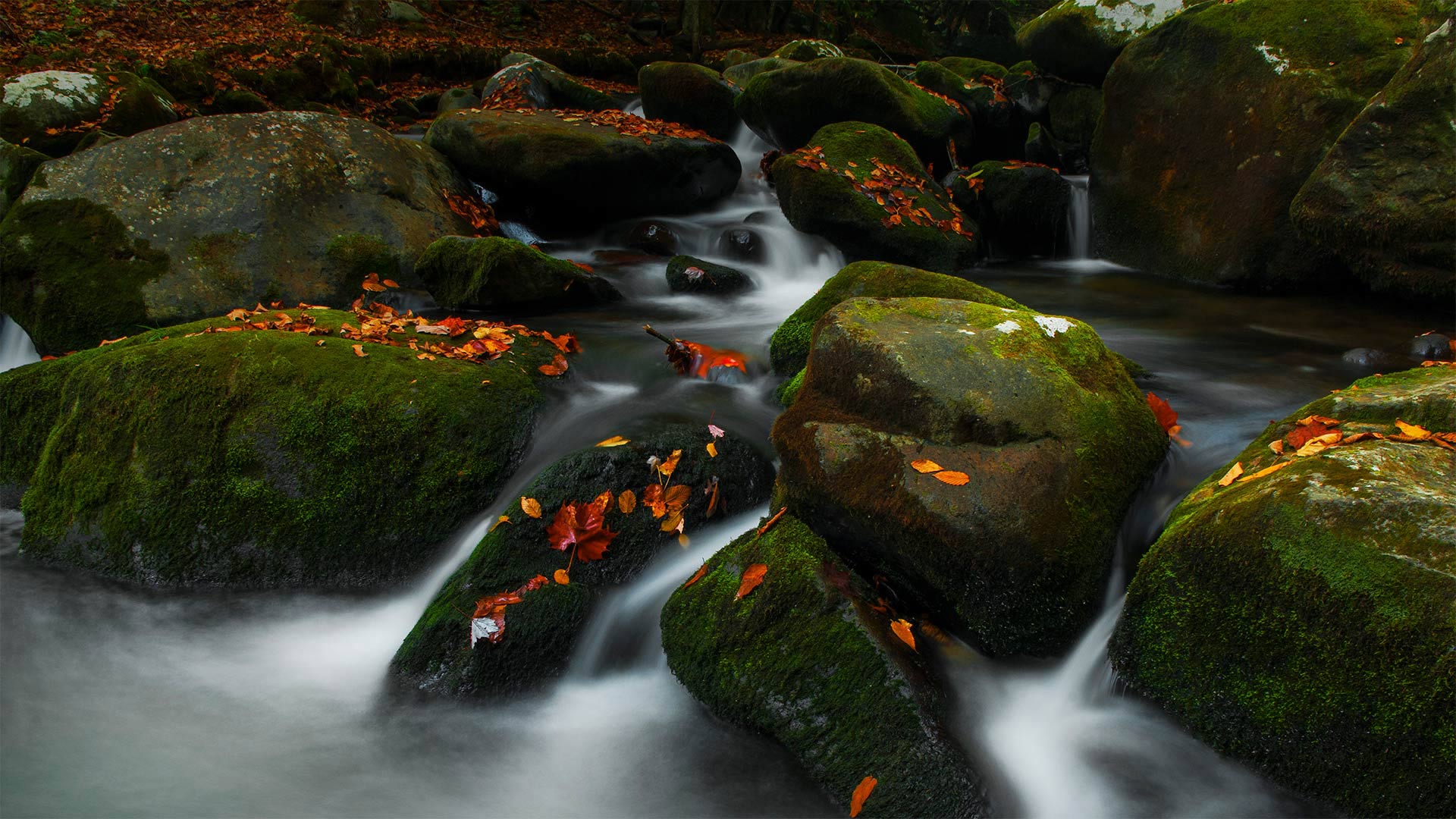
大雾山国家公园中的咆哮叉,田纳西州 Roaring Fork in Great Smoky Mountains National Park, Tennessee (© Bernie Kasper/Getty Images)
Falling for Tennessee
Although it might not look like it in this image of a tranquil fall day, Roaring Fork in the Great Smoky Mountains National Park has earned its ferocious name. The stream descends 2,500 feet over just 2 miles—a steep drop. After heavy rains, Roaring Fork transforms into a whitewater rush, the sound echoing off the mountainsides. But during drier spells, the stream quiets to more of a babbling brook, as seen here along the Roaring Fork Motor Nature Trail. The 5.5-mile popular loop drive passes waterfalls, well-preserved historic log cabins, and scenic overlooks of a forest that during this time of year reaches its fall color peak, exploding in bold yellows, oranges, and reds. These are just some of the things that make Great Smoky Mountains the most popular national park in the country.
Restormel城堡上空的秋雾,英国康沃尔 Autumn mist above Restormel Castle in Cornwall, England (© Robert Harding/Alamy)
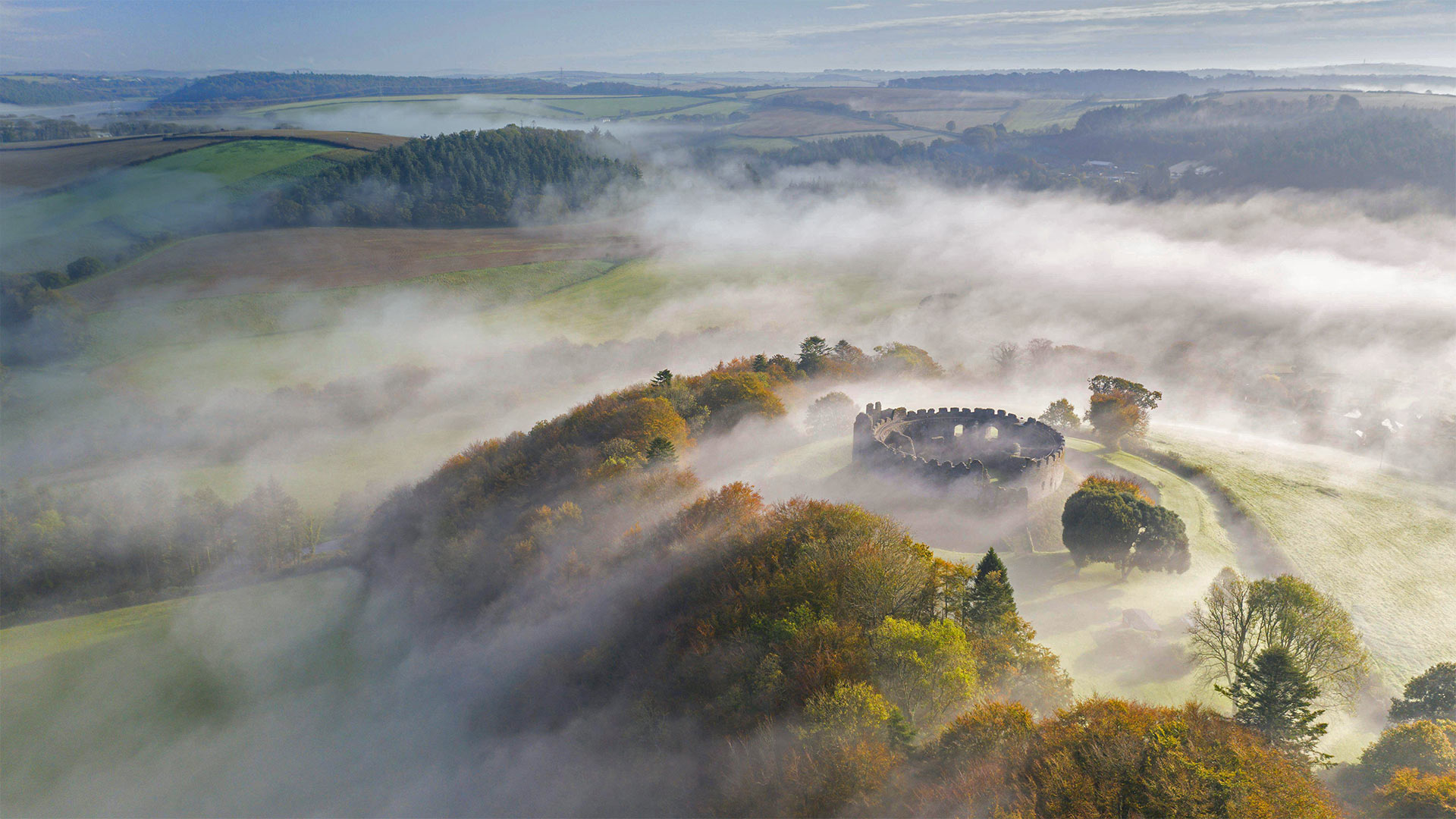
Restormel城堡上空的秋雾,英国康沃尔 Autumn mist above Restormel Castle in Cornwall, England (© Robert Harding/Alamy)
The circular castle of Cornwall
Many generations watched fog roll over this countryside long before the bellicose Norman visitors who built this fortress got the chance. The peninsula of Cornwall has been populated since the Mesolithic period 10,000 years ago, and is one of the traditional Celtic nations—areas of the British Isles and France where the Celts' culture survived Roman, Norman, and other outside influences despite repeated attempts at incursion.
Restormel Castle is one of the best-preserved keeps of its era in the UK, and also stands apart for its rare rotund shape. Built by the conquering Normans in the wake of their 1066 invasion of Britain, it was fortified as a perfect stone circle a hundred years later. Soon it was renovated into a luxurious palace with rudimentary plumbing and coveted hunting grounds. But after centuries of off-and-on use, it fell into disrepair after the English Civil War ended in 1651. It was acquired by the British government in the early 20th century. Open to the public, Restormel is now managed by the English Heritage charity trust.
运城盐湖,中国山西 Yuncheng Salt Lake in Yuncheng, Shanxi Province, China (© Xinhua/Alamy)
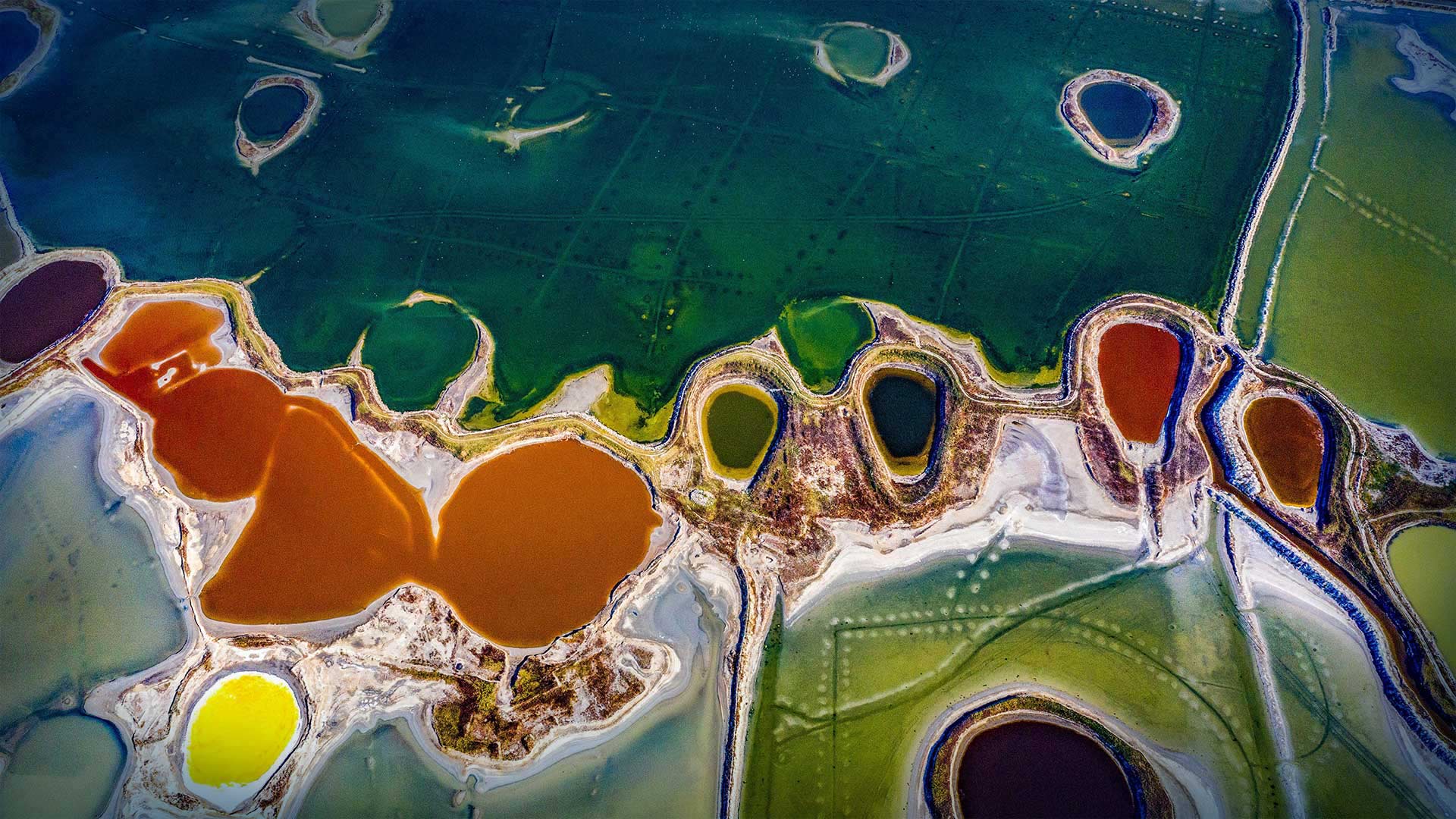
运城盐湖,中国山西 Yuncheng Salt Lake in Yuncheng, Shanxi Province, China (© Xinhua/Alamy)
Water colors
The Salt Lake in Yuncheng, China, has such a high salinity, it's sometimes called China's Dead Sea. But unlike the Dead Sea in the Middle East, Yuncheng's Salt Lake supports abundant microscopic life: algae and other microorganisms that have a high tolerance for the salt. In autumn, the lake temperature is high enough to spark algae blooms, bringing a variety of intense colors to the lake water.
Stranger still, during the cold, dry winter, the lake level drops, causing some of the sodium content in the water to form mirabilite rime—spiky, ice crystal-like mineral formations that make the lake shore and shallow surfaces look like an ice-covered landscape from science fiction.
栖息在斯诺希尔岛的成年帝企鹅和幼崽,南极 Emperor penguin adults and chicks at the Snow Hill Island rookery, Antarctica (© Martin Ruegner/Getty Images)
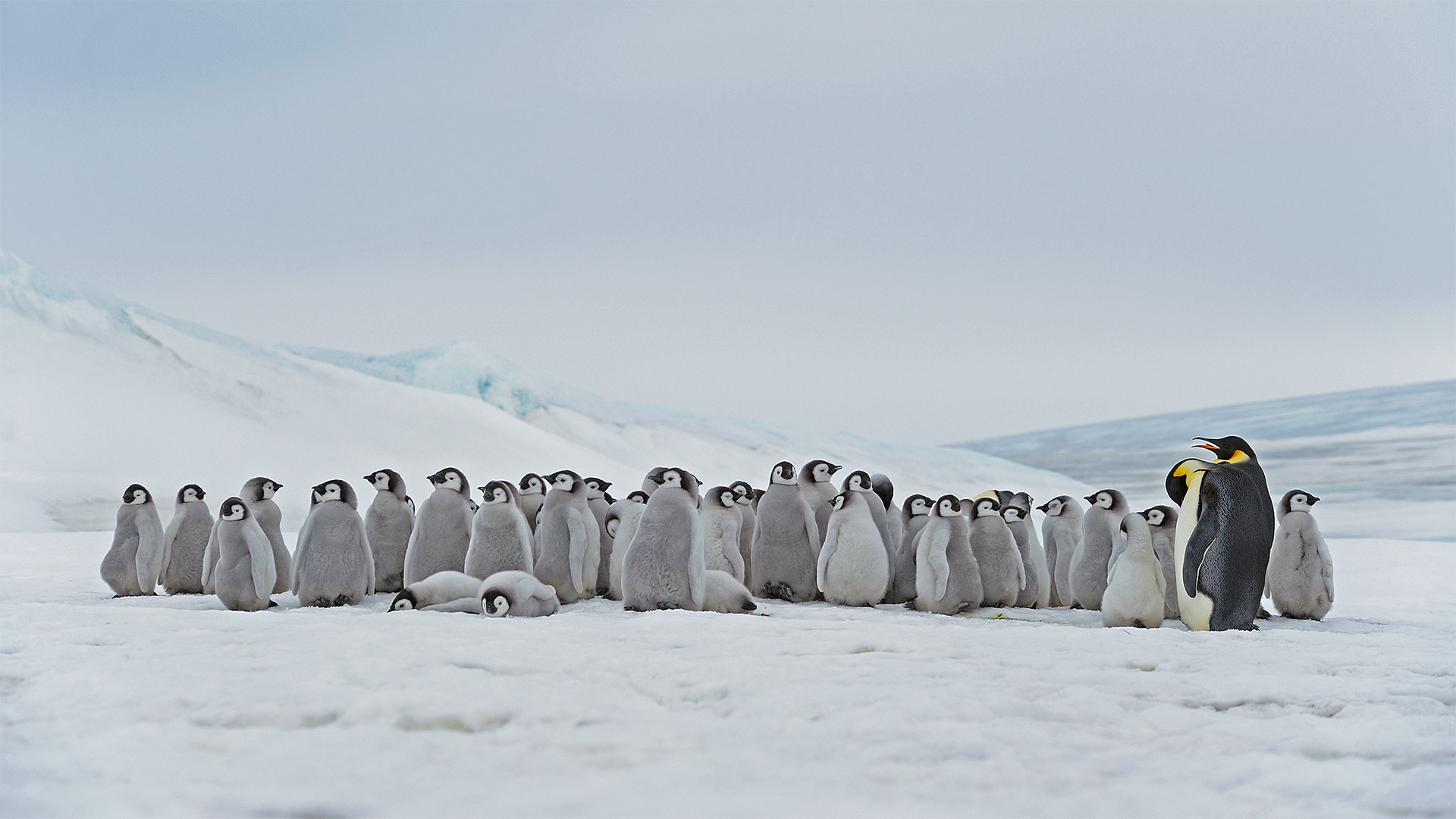
栖息在斯诺希尔岛的成年帝企鹅和幼崽,南极 Emperor penguin adults and chicks at the Snow Hill Island rookery, Antarctica (© Martin Ruegner/Getty Images)
Hey, you two in the front!
For World Teachers' Day, we're taking you to a class of emperor penguin chicks getting a lesson from a couple of wise adults—at least that's how it looks to us. All kidding aside, the celebration has a special significance this year. Educators dedicate their lives to engaging the minds of young and old alike, all the while sparking curiosity about the world around us. But with in-person classes widely curtailed due to the coronavirus pandemic, teachers have had to adapt their instruction methods, including the implementation of remote learning. More than ever we're grateful for their efforts, including their support to parents who are contributing at home.
Speaking of remote learning, the penguins in this photo live and learn in Antarctica at their breeding colony on Snow Hill Island. One thing we've learned on this World Teachers' Day: A group of chicks is called a rookery, but when mature, they become a waddle of adult penguins, a term that also describes their graceless walking gait. About that gait: Penguins rock side-to-side to raise their center of gravity and compensate for their wide feet and squat legs. You might think they expend a lot of energy getting around, but the percentage of energy retained per penguin stride—or recovery rate—is 80%. In comparison, the recovery rate for humans is a mere 65% (the two penguin chicks snoozing in today's photo probably already know that).
木星及木卫一的蒙太奇图像 Montage of images of Jupiter and its volcanic moon Io (© NASA/Johns Hopkins University Applied Physics Laboratory/Southwest Research Institute/Goddard Space Flight Center)
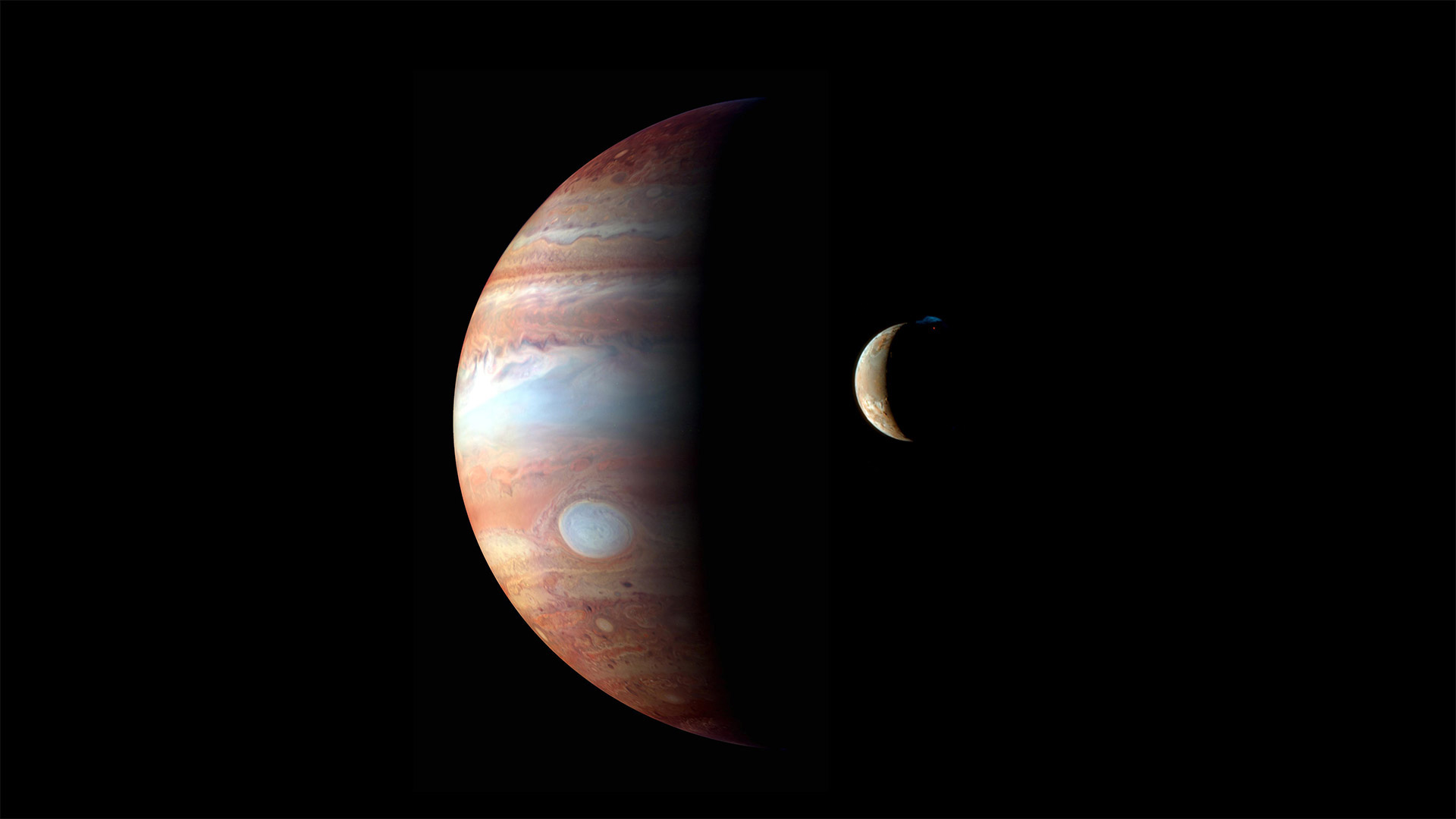
木星及木卫一的蒙太奇图像 Montage of images of Jupiter and its volcanic moon Io (© NASA/Johns Hopkins University Applied Physics Laboratory/Southwest Research Institute/Goddard Space Flight Center)
Infrared Jupiter, erupting Io
To celebrate World Space Week, we're featuring this montage of images of Jupiter courtesy of the New Horizons probe's flyby of the planet in 2007. If Jupiter looks a little different than you're used to seeing, it's because it was imaged using the space probe's near-infrared imaging spectrometer. In this false-color image, Jupiter's high-altitude clouds, like its stormy Great Red Spot, are rendered white, while deeper cloud formations take on reddish hues. The planet's innermost moon, Io, is captured in a true-color composite image during one of its frequent volcanic eruptions. A close look will show lava is glowing red beneath the blue and white plume of particles being ejected into the moon's thin atmosphere.
Space Week is a UN-recognized event that runs each year from October 4, which is the anniversary of the launch of Sputnik in 1957, to October 10, the anniversary of the signing of the Outer Space Treaty in 1967. This year's theme is 'Satellites Improve Life.'
从波迪安西之路的洛特谷中望向圣西尔克·拉波皮教堂,法国洛特 (© Reinhard Schmid/Huber/eStock Photo)
Owens River and the Sierra Nevada near Bishop, California (© Interfoto/Danita Delimont)
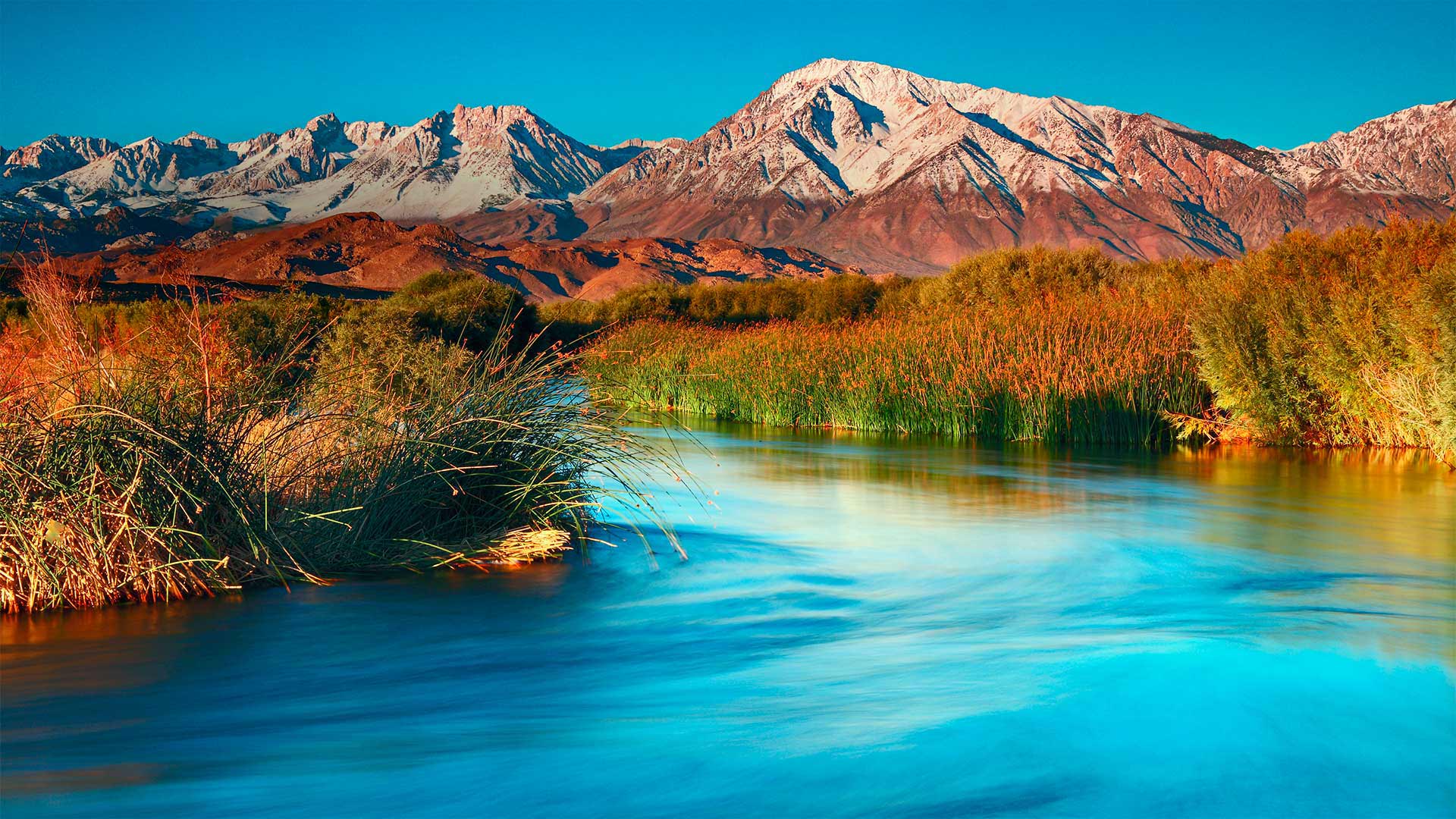
Owens River and the Sierra Nevada near Bishop, California (© Interfoto/Danita Delimont)
A wild and scenic scene
Some of our nation's most treasured rivers are protected thanks to a program that was first established on this day in 1968. The Wild and Scenic Rivers Act aims to preserve rivers with 'outstanding natural, cultural, and recreational values in a free-flowing condition for the enjoyment of present and future generations.' That's something we can get behind. This national system now protects more than 13,000 miles of 226 rivers. They flow through 41 states and the Commonwealth of Puerto Rico, from Idaho's Salmon River to the Missouri River in the Midwest to the Allagash River in Maine. Today's homepage visits the Owens River, near the Sierra Nevada in eastern California. About 19 miles of the Owens River headwaters were protected as a Wild and Scenic River in 2009, ensuring we'll see views like this for years to come.
